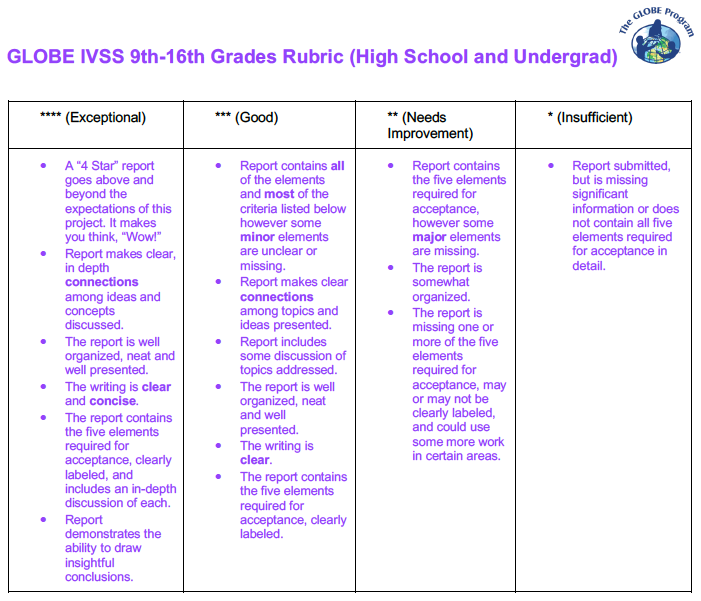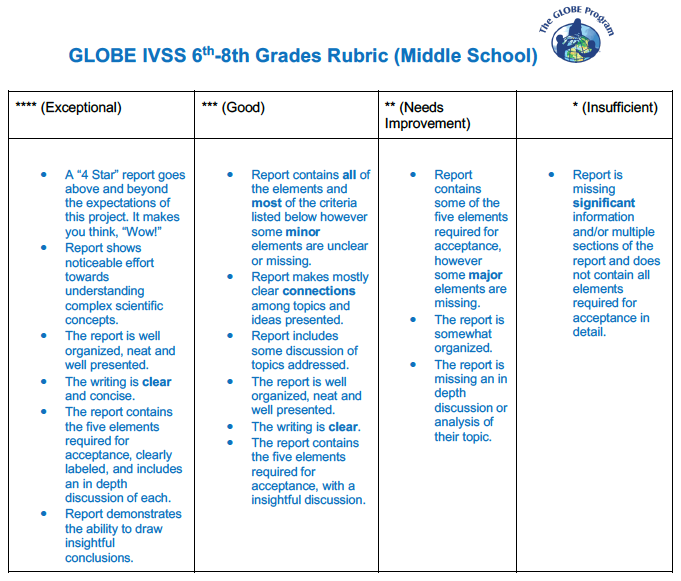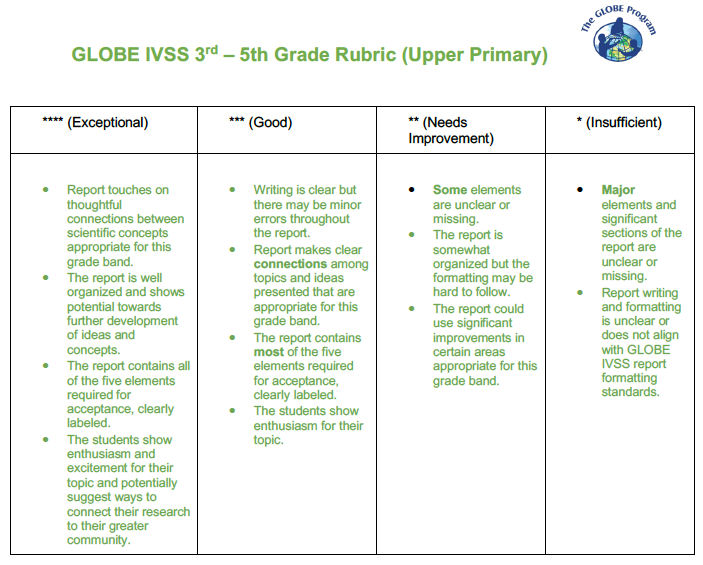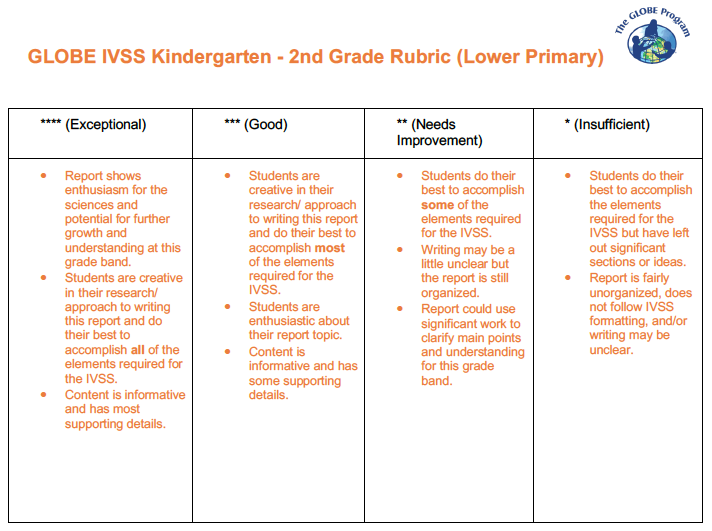VSS How Projects Are Reviewed
VSS: How Projects Are Reviewed
STEM professionals serve as volunteer reviewers to evaluate each submitted Virtual Science Symposium (VSS) project. Reviewers award badges and provide written feedback on projects submitted to the VSS.
Search and review IVSS submitted projects from 2025.
2026
STEM professionals will provide feedback on projects submitted to the Virtual Science Symposium using a feedback from provided by the GLOBE Implementation Office. Feedback will be focused on the research question(s), research methods, results, discussion/conclusion, and presentation organization. Reviewers will also award badges to highlight areas of excellence demonstrated in research projects.
In past years, age-appropriate rubrics were used to provide feedback to participants. Rubrics for the 2022-2025 symposia are listed below by grade level/age.2023 - 2025
| Four Stars (Exceptional) | Three Stars (Good) | Two Stars (Needs Improvement) | One Star (Insufficient) |
|---|---|---|---|
|
|
|
|
Project elements and criteria for High School and Undergraduate, ages 14-18+
* required element
1. Title*
- Concise (less than 15 words)
- Summarizes paper’s content
2. Abstract*
- Concise (less than 300 words)
- Context of research
- Research questions
- Objectives set
- Brief methods description
- Results
- Conclusions
- Recommendations for a way forward
- Key words that emphasize key ideas in the paper (3-5 words)
3. Research Questions*
- Include why they are important and are of scientific interest
- Concern some aspect of Earth’s environment (local or global issue)
- Provide significant insight into both the topic of investigation and the research process
- Answering them requires an advanced understanding of the subject matter
- Require a thoughtful research plan
- Are answerable through scientific research appropriate to the scope of the report
4. Introduction & Review of Literature
- Thorough (250-500 words)
- Description of the problem
- State of the science
- Importance
- Community relevance
- Citations in text (at least 3-5 references, including one primary source in a peer-reviewed journal. Do not include wikis or Q&A sites such as answers.com.
- Tip: Check out the The Purdue "OWL" for guidance and resources
5. Research Methods*
- There is a direct link provided between the datasets and research question(s)
- Study site: A map and description of the study site. It should mention area of study, climatic characteristics and basic aspects of land cover
- Data collection: A description of GLOBE protocols used to answer the research question as well as where and how data was gathered in the field (sampling method: Where, how many samples were measured)
- Print screen of data entry in the Web page of GLOBE.
- Data analysis: Mention what kind of mathematical calculation was applied to analyze the data
- The data presented are sufficient to answer the research question(s)
6. Results
- Tables and graphics applying statistical analysis of data to show mean, dispersion, or grouping data.
- Data support the conclusions
- Print screen of GLOBE Visualization page
7. Discussion
- Interpretation of results
- Possible sources of error
- Comparison with similar studies
- Discuss whether results support the hypothesis or not, and why
8. Conclusion*
- Gives a thorough and insightful explanation as to how the conclusion was reached
- Put findings in context, why it's important/relevant, impact, with regard to the science
- What improvements in methods
- What follow-on research/actions to be taken, future protocols that could be added
- Impact of working with a project mentor
9. Bibliography/Citations
- Materials correctly cited
- GLOBE materials used
- Sources beyond those powered by GLOBE
| Four Stars (Exceptional) | Three Stars (Good) | Two Stars (Needs Improvement) | One Star (Insufficient) |
|---|---|---|---|
|
|
|
|
Project elements and criteria for Middle School, ages 11-14 yrs
* required element
1. Title*
- Concise (less than 15 words)
- Summarizes paper’s content
2. Abstract*
- Concise (less than 300 words)
- Context of research
- Research questions
- Objectives set
- Brief methods description
- Results
- Conclusions
- Recommendations for a way forward
- Key words that emphasize key ideas in the paper (3-5 words)
3. Research Questions*
- Include why they are important and are of scientific interest
- Concern some aspect of Earth’s environment (local or global issue)
- Provide significant insight into both the topic of investigation and the research process
- Answering them requires an advanced understanding of the subject matter
- Require a thoughtful research plan
- Are answerable through scientific research appropriate to the scope of the report
4. Introduction & Review of Literature
- Thorough (250-500 words)
- Description of the problem
- State of the science
- Importance
- Community relevance
- Citations in text (at least 3-5 references, including one primary source in a peer-reviewed journal. Do not include wikis or Q&A sites such as answers.com.
- Tip: Check out the The Purdue "OWL" for guidance and resources
5. Research Methods*
- There is a direct link provided between the datasets and research question(s)
- Study site: A map and description of the study site. It should mention area of study, climatic characteristics and basic aspects of land cover
- Data collection: A description of GLOBE protocols used to answer the research question as well as where and how data was gathered in the field (sampling method: Where, how many samples were measured)
- Print screen of data entry in the Web page of GLOBE.
- Data analysis: Mention what kind of mathematical calculation was applied to analyze the data
- The data presented are sufficient to answer the research question(s)
6. Results
- Tables and graphics applying statistical analysis of data to show mean, dispersion, or grouping data.
- Data support the conclusions
- Print screen of GLOBE Visualization page
7. Discussion
- Interpretation of results
- Possible sources of error
- Comparison with similar studies
- Discuss whether results support the hypothesis or not, and why
8. Conclusion*
- Gives a thorough and insightful explanation as to how the conclusion was reached
- Put findings in context, why it's important/relevant, impact, with regard to the science
- What improvements in methods
- What follow-on research/actions to be taken, future protocols that could be added
- Impact of working with a project mentor
9. Bibliography/Citations
- Materials correctly cited
- GLOBE materials used
- Sources beyond those powered by GLOBE
| Four Stars (Exceptional) | Three Stars (Good) | Two Stars (Needs Improvement) | One Star (Insufficient) |
|---|---|---|---|
|
|
|
|
Project elements and criteria for Grades 3-5 Upper Primary, ages 8-11
* required element
1. Title*
- Concise (less than 15 words)
- Summarizes paper’s content
2. Summary*
- The problem
- Research questions
- Objectives set
- Conclusions
3. Research Questions*
- Include why they are important and are of scientific interest
- Concern some aspect of Earth’s environment (local or global issue)
- Provide significant insight into both the topic of investigation and the research process
- Require a thoughtful research plan
- Are answerable through scientific research appropriate to the scope of the report
4. Introduction
- Description of the problem
- Importance
- Community relevance
5. Research Methods*
- There is a direct link provided between the datasets and research question(s)
- Study site: A map and description of the study site. It should mention area of study, climatic characteristics and basic aspects of land cover
- Data collection: A description of GLOBE protocols used to answer the research question as well as where and how data was gathered in the field (sampling method: Where, how many samples were measured)
- Print screen of data entry in the Web page of GLOBE.
- The data presented are sufficient to answer the research question(s)
6. Results
- Tables and graphics of data
- Data support the conclusions
8. Conclusion*
- Gives a thorough and insightful explanation as to how the conclusion was reached
- Put findings in context, stating why they are important or relevant
- What follow-on research and actions could be taken; future protocols that could be added
- Impact of working with a project mentor
9. Bibliography
- Materials listed
- GLOBE materials used
| Four Stars (Exceptional) | Three Stars (Good) | Two Stars (Needs Improvement) | One Star (Insufficient) |
|---|---|---|---|
|
|
|
|
Project elements and criteria for Grades K-2, ages 5-8
* required element
1. Title*
- Concise (less than 15 words)
- Summarizes paper’s content
2. Summary*
- The problem
- Research questions
- Conclusions
3. Research Questions*
- Include why they are important and are of scientific interest
- Concern some aspect of Earth’s environment (local or global issue)
- Are answerable through scientific research appropriate to the scope of the report
5. Research Methods*
- There is a direct link provided between the datasets and research question(s)
- Data collection: A description of GLOBE protocols used to answer the research question as well as where and how data was gathered in the field (sampling method: Where, how many samples were measured)
- The data presented are sufficient to answer the research question(s)
6. Results
- Tables and graphics of data
- Data support the conclusions
8. Conclusion*
- Gives a thoughtful explanation as to how the conclusion was reached
- Put findings in context, stating why they are important or relevant
- Impact of working with a project mentor or teacher(s)
2022

Project elements and criteria for High School and Undergraduate, ages 14-18+
* required element
1. Title*
- Concise (less than 15 words)
- Summarizes paper’s content
2. Abstract*
- Concise (less than 300 words)
- Context of research
- Research questions
- Objectives set
- Brief methods description
- Results
- Conclusions
- Recommendations for a way forward
- Key words that emphasize key ideas in the paper (3-5 words)
3. Research Questions*
- Include why they are important and are of scientific interest
- Concern some aspect of Earth’s environment (local or global issue)
- Provide significant insight into both the topic of investigation and the research process
- Answering them requires an advanced understanding of the subject matter
- Require a thoughtful research plan
- Are answerable through scientific research appropriate to the scope of the report
4. Introduction & Review of Literature
- Thorough (250-500 words)
- Description of the problem
- State of the science
- Importance
- Community relevance
- Citations in text (at least 3-5 references, including one primary source in a peer-reviewed journal. Do not include wikis or Q&A sites such as answers.com.
- Tip: Check out the The Purdue "OWL" for guidance and resources
5. Research Methods*
- There is a direct link provided between the datasets and research question(s)
- Study site: A map and description of the study site. It should mention area of study, climatic characteristics and basic aspects of land cover
- Data collection: A description of GLOBE protocols used to answer the research question as well as where and how data was gathered in the field (sampling method: Where, how many samples were measured)
- Print screen of data entry in the Web page of GLOBE.
- Data analysis: Mention what kind of mathematical calculation was applied to analyze the data
- The data presented are sufficient to answer the research question(s)
6. Results
- Tables and graphics applying statistical analysis of data to show mean, dispersion, or grouping data.
- Data support the conclusions
- Print screen of GLOBE Visualization page
7. Discussion
- Interpretation of results
- Possible sources of error
- Comparison with similar studies
- Discuss whether results support the hypothesis or not, and why
8. Conclusion*
- Gives a thorough and insightful explanation as to how the conclusion was reached
- Put findings in context, why it's important/relevant, impact, with regard to the science
- What improvements in methods
- What follow-on research/actions to be taken, future protocols that could be added
- Impact of working with a project mentor
9. Bibliography/Citations
- Materials correctly cited
- GLOBE materials used
- Sources beyond those powered by GLOBE

Project elements and criteria for Middle School, ages 11-14 yrs
* required element
1. Title*
- Concise (less than 15 words)
- Summarizes paper’s content
2. Abstract*
- Concise (less than 300 words)
- Context of research
- Research questions
- Objectives set
- Brief methods description
- Results
- Conclusions
- Recommendations for a way forward
- Key words that emphasize key ideas in the paper (3-5 words)
3. Research Questions*
- Include why they are important and are of scientific interest
- Concern some aspect of Earth’s environment (local or global issue)
- Provide significant insight into both the topic of investigation and the research process
- Answering them requires an advanced understanding of the subject matter
- Require a thoughtful research plan
- Are answerable through scientific research appropriate to the scope of the report
4. Introduction & Review of Literature
- Thorough (250-500 words)
- Description of the problem
- State of the science
- Importance
- Community relevance
- Citations in text (at least 3-5 references, including one primary source in a peer-reviewed journal. Do not include wikis or Q&A sites such as answers.com.
- Tip: Check out the The Purdue "OWL" for guidance and resources
5. Research Methods*
- There is a direct link provided between the datasets and research question(s)
- Study site: A map and description of the study site. It should mention area of study, climatic characteristics and basic aspects of land cover
- Data collection: A description of GLOBE protocols used to answer the research question as well as where and how data was gathered in the field (sampling method: Where, how many samples were measured)
- Print screen of data entry in the Web page of GLOBE.
- Data analysis: Mention what kind of mathematical calculation was applied to analyze the data
- The data presented are sufficient to answer the research question(s)
6. Results
- Tables and graphics applying statistical analysis of data to show mean, dispersion, or grouping data.
- Data support the conclusions
- Print screen of GLOBE Visualization page
7. Discussion
- Interpretation of results
- Possible sources of error
- Comparison with similar studies
- Discuss whether results support the hypothesis or not, and why
8. Conclusion*
- Gives a thorough and insightful explanation as to how the conclusion was reached
- Put findings in context, why it's important/relevant, impact, with regard to the science
- What improvements in methods
- What follow-on research/actions to be taken, future protocols that could be added
- Impact of working with a project mentor
9. Bibliography/Citations
- Materials correctly cited
- GLOBE materials used
- Sources beyond those powered by GLOBE

Project elements and criteria for Grades 3-5 Upper Primary, ages 8-11
* required element
1. Title*
- Concise (less than 15 words)
- Summarizes paper’s content
2. Summary*
- The problem
- Research questions
- Objectives set
- Conclusions
3. Research Questions*
- Include why they are important and are of scientific interest
- Concern some aspect of Earth’s environment (local or global issue)
- Provide significant insight into both the topic of investigation and the research process
- Require a thoughtful research plan
- Are answerable through scientific research appropriate to the scope of the report
4. Introduction
- Description of the problem
- Importance
- Community relevance
5. Research Methods*
- There is a direct link provided between the datasets and research question(s)
- Study site: A map and description of the study site. It should mention area of study, climatic characteristics and basic aspects of land cover
- Data collection: A description of GLOBE protocols used to answer the research question as well as where and how data was gathered in the field (sampling method: Where, how many samples were measured)
- Print screen of data entry in the Web page of GLOBE.
- The data presented are sufficient to answer the research question(s)
6. Results
- Tables and graphics of data
- Data support the conclusions
8. Conclusion*
- Gives a thorough and insightful explanation as to how the conclusion was reached
- Put findings in context, stating why they are important or relevant
- What follow-on research and actions could be taken; future protocols that could be added
- Impact of working with a project mentor
9. Bibliography
- Materials listed
- GLOBE materials used

Project elements and criteria for Grades K-2, ages 5-8
* required element
1. Title*
- Concise (less than 15 words)
- Summarizes paper’s content
2. Summary*
- The problem
- Research questions
- Conclusions
3. Research Questions*
- Include why they are important and are of scientific interest
- Concern some aspect of Earth’s environment (local or global issue)
- Are answerable through scientific research appropriate to the scope of the report
5. Research Methods*
- There is a direct link provided between the datasets and research question(s)
- Data collection: A description of GLOBE protocols used to answer the research question as well as where and how data was gathered in the field (sampling method: Where, how many samples were measured)
- The data presented are sufficient to answer the research question(s)
6. Results
- Tables and graphics of data
- Data support the conclusions
8. Conclusion*
- Gives a thoughtful explanation as to how the conclusion was reached
- Put findings in context, stating why they are important or relevant
- Impact of working with a project mentor or teacher(s)





